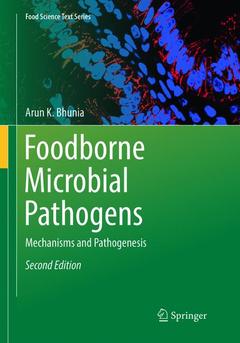Foodborne Microbial Pathogens (2nd Ed., 2nd ed. 2018) Mechanisms and Pathogenesis Food Science Text Series
Auteur : Bhunia Arun K.

This book primarily covers the general description of foodborne pathogens and their mechanisms of pathogenesis, control and prevention, and detection strategies, with easy-to-comprehend illustrations. The book is an essential resource for food microbiology graduate or undergraduate students, microbiology professionals, and academicians involved in food microbiology, food safety, and food defense-related research or teaching. This new edition covers the significant progress that has been made since 2008 in understanding the pathogenic mechanism of some common foodborne pathogens, and the host-pathogen interaction. Foodborne and food-associated zoonotic pathogens, responsible for high rates of mortality and morbidity, are discussed in detail. Chapters on foodborne viruses, parasites, molds and mycotoxins, and fish and shellfish are expanded. Additionally, chapters on opportunistic and emerging foodborne pathogens including Nipah virus, Ebola virus, Aeromonas hydrophila, Brucella abortus, Clostridium difficile, Cronobacter sakazakii, and Plesiomonas shigelloides have been added. The second edition contains more line drawings, color photographs, and hand-drawn illustrations.
Prof. Arun K. Bhunia received his bachelor of veterinary medicine degree (BVSc) from West Bengal University of Fishery and Animal Sciences (West Bengal, Kolkata India), PhD from University of Wyoming (USA), and postdoctoral training from University of Arkansas (USA). Currently, he is a professor of food microbiology at Purdue University (USA) and the Chair of Microbiology Training Group of Purdue University interdisciplinary Life Sciences program (PULSe). He is also affiliated with the Department of Comparative Pathobiology, and Center for Food Safety and Engineering. His expertise is in the area of microbial pathogenesis, microbial food safety, foodborne pathogen detection, and probiotic vaccine. To date, he has coauthored more than 166 peer-reviewed research publications, 2 textbooks (Fundamental Food Microbiology; Foodborne Microbial Pathogens), edited four books, and delivered over 120 talks in national and international venues. He teaches both graduate and under graduate level courses on foodborne pathogens and mechanism of pathogenesis, microbial detection techniques, and food safety and public health. He is awarded four patents. He is serving as editor or editorial board member for several journals. He is an active member of Institute of Food Technology (IFT), International Association for Food Protection (IAFP), and American Society for Microbiology (ASM), and the USDA National Advisory Committee on Microbiological Criteria for Foods (NACMCF; 2013-2017). He has received Purdue Agriculture Research Award (2003), Purdue Faculty Scholar (2005), Purdue Team Award (2006), IFT R&D Award (2009), Outstanding Graduate Educator Award from the Department of Food Science (2010, 2011) and the College of Agriculture (2013) at Purdue University, High-End Foreign Experts Recruitment Program (China) fellowship (2014-2016), Fulbright Specialist Roster (2016-2021), and (IAFP) Maurice Weber Laboratorian Award (2017).
This second edition covers the significant progress that has been made since 2008 in understanding the pathogenic mechanism of some common foodborne pathogens, and the host-pathogen interaction
Chapters on opportunistic and emerging foodborne pathogens including Nipah virus, Ebola virus, Aeromonas hydrophila, Brucella abortus, Clostridium difficile, Cronobacter sakazakii, and Plesiomonas shigelloides have been added
Foodborne and food-associated zoonotic pathogens, responsible for high rates of mortality and morbidity, are discussed in detail
Date de parution : 07-2019
Ouvrage de 365 p.
17.8x25.4 cm
Disponible chez l'éditeur (délai d'approvisionnement : 15 jours).
Prix indicatif 84,39 €
Ajouter au panierDate de parution : 05-2018
Ouvrage de 365 p.
17.8x25.4 cm
Disponible chez l'éditeur (délai d'approvisionnement : 15 jours).
Prix indicatif 116,04 €
Ajouter au panierThèmes de Foodborne Microbial Pathogens :
Mots-clés :
Food microbiology; Food microorganisms; food spoilage; foodborne pathogens; Food safety



